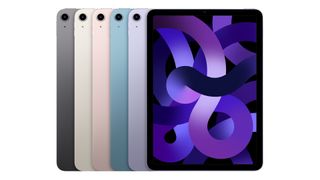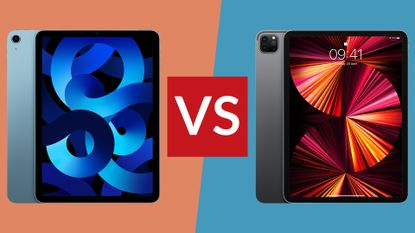The release of the iPad Pro, with its M1 chip, was an absolute revelation - here was the best iPad ever, an iPad not just at the top of its own game but one which could compete seriously with the best laptops. But Apple being Apple, it's gone and created its own competition yet again.
The new iPad Air isn't outwardly different, but it internally makes up the ground the previous generation lost by adding the same M1 chip you'll find in the iPad Pro and optional 5G support. Where the Air used to be very much second place behind its super-powered sibling, this new version offers whole lot more muscle for your money.
In the sense of apples-to-apples fairness here, we're comparing the two models closest in size: the 11-inch iPad Pro and the iPad Air, which has a 10.9-inch screen. If you're looking at mid-range iPads today, you'll see just how similar these are – even in price. There is the iPad Pro 12.9-inch (2021) if you want something bigger, of course – that has a clearer advantage over the iPad Air.
So with the smallest iPad Pro being the same size and design as the iPad Air, what are the differences now? Here's what you need to know.
iPad Air 5 vs iPad Pro 11-inch: Price
Value is kind of the iPad Air's wheelhouse, and always has been. Not cheapness, as such, because the bog-standard iPad has that covered, but there's no better bang for your buck. That's doubly true here: while the new iPad Air doesn't carry every extravagant feature that the Pro does, it omits very little that we'd call essential and offers a significant price disparity over its top-of-the-line competition. The iPad Air costs $599/£569 for the 64GB Wi-Fi version, and up to $899/£869 for the 256GB 5G-capable edition.
The 11-inch iPad Pro is more capable and thus more expensive – but perhaps not as much as you'd think, starting at $799/£749 for the 128GB Wi-Fi edition. You have more options for speccing it up with storage, though – if you want 2TB of storage and 5G connectivity you'll have to pay $2,099/£1,899 for the privilege.
iPad Air 5 vs iPad Pro 11-inch: Size & screen

The iPad Air comes in Space Gray, Starlight, and the less-branded colours of Pink, Blue and Purple
Comparing actual size and weight, the iPad Air moniker continues to look a little redundant; the iPad Pro is actually marginally thinner at 5.9mm (0.23 inches) vs the Air's 6.1mm (0.24 inches), and the Pro is only between five and six grams heavier, in the models' Wi-Fi and 5G versions respectively.
Both share the exact same edge-to-edge chassis dimensions, and compatibility with the same cases and accessories as long as they take into account the difference in the camera clusters – though the Pro's slightly-larger screen offers it a microscopically smaller bezel.
About those screen panels, then. The 11-inch Pro features a sumptuous 600 nits of peak brightness with a 120Hz ProMotion refresh rate. The resolution is 2388x1668.
This is all slightly better than the iPad Air, which is still locked at 60Hz and a max of 500 nits. The resolution is 2360x1640.
The Pro's extra brightness is clearly visible when watching movies, playing games or looking at photos, where it adds some real extra punch. But when just using apps or browsing the web, it doesn't make a big difference.
The 120Hz screen is really only of practical use for drawing – it makes the screen respond faster to Apple Pencil input. It does also make the screen look smoother and sharper during scrolling or animations at other times, but this is entirely cosmetic.
The iPad Pro's screen is objectively better, but in ways that only a few people will find essential in any way.
iPad Air 5 vs iPad Pro 11-inch: Performance & battery
We've reached parity again. The new iPad Air features the same M1 processor at the heart of the iPad Pro, which can also be found in the MacBook Air (M1, 2020) and MacBook Pro 13-inch (M1, 2020). That's a big performance boost, and it means both tablets now offer the same processor and GPU performance, the same image processing smarts, and Neural Engine power.
You get 8 processor cores, 8 GPU cores and 8GB of RAM. Performance is incredibly fast in iPadOS, and is capable of high-end creative work when needed.
Apple reckons the M1 chip in the iPad Air offers it better battery life than the previous model, but it remains to be seen just how long it'll last in practise. Both the current iPad Pro and the last iPad Air managed around 10 hours on a charge, and we'd expect that to stay the same this time around – it's a figure Apple consistently hits.
iPad Air 5 vs iPad Pro 11-inch: Connectivity

You can have an iPad Pro in any colour you like as long as it's (some variation of) black: your options are Space Gray or Silver
Apple had to hold something back inside the new iPad Air. Its USB-C port is one area where it hasn't been given quite the same spec as the iPad Pro; it's still just USB-C, while the iPad Pro includes a Thunderbolt 4 port (which double as a USB-C port). The iPad Air does use USB 3.1 Gen 2, which puts it at 20Gb/sec transfer speed, compared to the Thunderbolt-capable iPad Pro, which runs at 40Gb/sec.
The iPad Air's transfer speeds aren't slow, by any means, but their bandwidth does mean slightly more limited potential. You won't be able to pull off the Pro's party piece of connecting to two 4K displays, for example, but a single 4K screen wouldn't be a problem.
The 2022 iPad Air does match up to the Pro in terms of its wireless radios, however: if you opt for the cellular versions, both now offer 5G connectivity, while both feature Wi-Fi 6 (aka 802.11ax) and Bluetooth 5.0.

The iPad Air's rear camera gets a pretty hefty bump.
iPad Air 5 vs iPad Pro 11-inch: Camera
The latest iPad Pro introduced a laundry list of camera improvements, prime amongst them its 12MP ultra-wide selfie cam with Centre Stage, which tracks you around the room and pans and zooms to keeps you in frame. It also has a TrueDepth 3D sensor, so you can also use it for tweakable Portrait shots and to animate an Animoji.
On the rear, you've got a 12MP wide angle camera and a 12MP ultra-wide camera, plus a LIDAR sensor for 3D depth detection.
The new iPad Air? It gets an identical package up front, Centre Stage and all. But you've got just a single 12MP wide-angle camera on the back, and no LIDAR.
The iPad Pro simply offers more flexibility, and the LIDAR provides some great niche options, such as in AR applications.
iPad Air 5 vs iPad Pro 11-inch: Conclusion
Objectively the 11-inch iPad Pro is the better of these two devices. It has a stronger screen, offers more versatility in its cameras, and has a faster USB-C port, with more storage. But at $200/£200 more than the iPad Air, you have to really want these features – and most people won't be bothered by them at all. The iPad Air can basically do everything that matters for a whole lot less money.
Apple has, at least until we see a new iPad Pro, restored the truth of the previous generation of these tablets – that the Air is for everyone, and the Pro is really only for those that need it.



